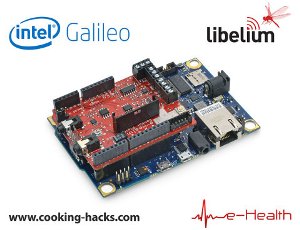Libelium has released step-by-step tutorials that show how to connect Arduino and Raspberry Pi shields and modules to the Intel Galileo development board, to help developers design new Internet of Things applications with software and hardware.
Libelium received support from Intel’s technical team to program a new API for its e-Health Sensor Platform, the first open source platform, that collects and transmits biometric data for healthcare applications. Libelium will be demonstrating the Intel Galileo and e-Health Sensor Platform integration at Maker Faire Bay Area, May 17-18, at booth #231.
 The Intel Galileo and e-Health Sensor Platform integration will be shown at Maker Faire Bay Area, May 17-18, 2014 at Cooking Hacks booth #231. Cooking Hacks is the open hardware division of Libelium. (Graphic: Business Wire
The Intel Galileo and e-Health Sensor Platform integration will be shown at Maker Faire Bay Area, May 17-18, 2014 at Cooking Hacks booth #231. Cooking Hacks is the open hardware division of Libelium. (Graphic: Business Wire
Using the Libelium tutorials, any Arduino wireless module may be connected to Intel Galileo, including RFID, NFC, Bluetooth, BLE, Wi-Fi, GPRS, 3G, GPS, all communication modules developed by Cooking Hacks, Libelium’s open hardware division, as well as any sensor and actuator (analog 0-5v, digital). The Intel Galileo is based on the singlecore 32bit, 400MHz Quark SoC X1000 processor, supports 3.3 or 5 volt shields and has an Ethernet and USB port. Galileo software supports the Arduino shield ecosystem and is compatible with Windows, Mac OS and Linux.
“All our shields, boards and modules designed for Arduino and Raspberry Pi have now been tested over Intel Galileo, and are ready for prime time. We aim to help developers combine the Arduino pinout with the power and capabilities of the Intel core to build new IoT applications using Galileo,” said David Gascón, CTO at Libelium.
“We launched the Intel IoT Developer Program earlier this year with a goal to encourage the broad ecosystem adoption of Intel Galileo,” said Morris Beton, Intel Software and Services Group Vice President and General Manager. “Libelium’s e-Health sensors platform on Intel Galileo is a great example of industry collaboration that will enable developers to build creative IoT solutions in the health care space.”
Technical Characteristics – Intel Galileo Tutorials
| Key Features |
|
Why it Matters |
| The Intel Galileo is a development board based on the IntelQuark SoC X1000, a 32bit Intel Pentium brand system on a chip. |
|
The Intel Galileo has built-in networking and more memory capability than other boards, making it easy to combine libraries and incorporate large display functions. |
| First board based on Intel architecture designed to be hardware and software pin-compatible with Arduino Uno R3, and the Arduino software development environment (IDE). |
|
Usability and serial communication are easy to implement. The Intel Galileo has USB host support, and can interface with many different devices, such as webcams, etc. |
| Support for Microsoft Windows, Mac OS and Linux host operating systems, and the Arduino software integrated environment. |
|
The Intel Galileo development board allows to quickly prototype interactive Arduino-compatible designs for new projects from home automation to robotics. |
| Modules and shields compliant with Intel Galileo include:
e-Health Sensor Platform
GPRS / GSM Quadband shield (SIM900)
GPRS / GSM Geolocation Tracker shield (SIM908)
3G + GPS shield
RFID 125 KHz shield
RFID 13.56 MHz/ NFC shield
GPS module
Bluetooth PRO module
Wi-Fi module
Geiger counter – Radiation Sensor board
|
For more information: http://www.cooking-hacks.com/documentation/tutorials/intel-galileo-tutorial-using-arduino-and-raspberry-pi-shields-modules-boards